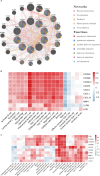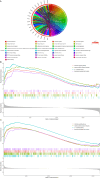Uncovering common disease mechanisms and critical biomarkers in Crohn's disease with concurrent psoriasis and exploring potential therapeutic agents
- PMID: 40540498
- PMCID: PMC12180644
- DOI: 10.1371/journal.pone.0324007
Uncovering common disease mechanisms and critical biomarkers in Crohn's disease with concurrent psoriasis and exploring potential therapeutic agents
Abstract
Introduction: Research findings show a substantial correlation between Crohn's disease and psoriasis. However, the exact cause or pathogenesis of the concurrent manifestations of these two conditions in the same individuals remains uncertain. This research aimed to scrutinize the important molecules and mechanisms responsible for the concomitance of Crohn's disease and Psoriasis by using quantitative bioinformatics utilizing a publicly available RNA sequencing repository.
Methods: The database Gene Expression Omnibus were assessed, specifically for Crohn's disease (GSE95095) and psoriasis (GSE13355). The 'limma' library of the R programming syntax is employed to identify differentially expressed genes. The Search Tool for Interacting Genes dataset was utilized to study the interaction between proteins networks. The Cytoscape software was utilized to efficiently view and analyse these Protein-Protein Interaction networks. The ctoHubba Cytoscape plugin helps in the selection of hub genes. These hub genes have been confirmed using data from GSE102133 for Crohn's disease and GSE14905 for psoriasis. The ROC curves were utilized in this study to assess the diagnostic value of the hub genes. Moreover, new research involving gene-set enriched studies and the study of immunological surveillance associated with these specific genes is attainable.
Results: Among the identified common DEGs, 40 genes were downregulated and 37 were upregulated, totaling 77 genes. Crohn's disease and Psoriasis had a higher concentration of pathways associated with inflammation. After validation, functionality of hub genes was confirmed for S100A12, CXCL8, IL1RN, S100A9, CXCL10, MMP1, CXCL1, FPR1, CXCR2, and S100A8. The hub genes showed an increase in expression in response to neutrophil infiltration. The expression of S100A12, CXCL8, IL1RN, S100A9, CXCL10, MMP1, CXCL1, FPR1, CXCR2, and S100A8 was found to be significantly linked to immune processes such as neutrophil activation, neutrophil chemotaxis, and neutrophil migration associated with Crohn's and Psoriasis disease.
Conclusions: This bioinformatics study has elucidated S100A12, CXCL8, IL1RN, S100A9, CXCL10, MMP1, CXCL1, FPR1, CXCR2, and S100A8 as the central genes in the pathogenesis of CD and Psoriasis comorbidity. The significance of neutrophil infiltration in promoting inflammatory and immune-mediated dysfunction seems to be crucial in the etiology of concurrent Crohn's and Psoriasis, offering an avenue for diagnostic and therapeutic methods.
Copyright: © 2025 Liu et al. This is an open access article distributed under the terms of the Creative Commons Attribution License, which permits unrestricted use, distribution, and reproduction in any medium, provided the original author and source are credited.
Conflict of interest statement
The authors have declared that no competing interests exist.
Figures







Similar articles
-
Identification of ubiquitination-related key biomarkers and immune infiltration in Crohn's disease by bioinformatics analysis and machine learning.Sci Rep. 2025 Jan 27;15(1):3444. doi: 10.1038/s41598-025-88148-4. Sci Rep. 2025. PMID: 39870856 Free PMC article.
-
Natalizumab for induction of remission in Crohn's disease.Cochrane Database Syst Rev. 2006 Jul 19;(3):CD006097. doi: 10.1002/14651858.CD006097. Cochrane Database Syst Rev. 2006. Update in: Cochrane Database Syst Rev. 2007 Jan 24;(1):CD006097. doi: 10.1002/14651858.CD006097.pub2. PMID: 16856112 Updated.
-
Systemic pharmacological treatments for chronic plaque psoriasis: a network meta-analysis.Cochrane Database Syst Rev. 2021 Apr 19;4(4):CD011535. doi: 10.1002/14651858.CD011535.pub4. Cochrane Database Syst Rev. 2021. Update in: Cochrane Database Syst Rev. 2022 May 23;5:CD011535. doi: 10.1002/14651858.CD011535.pub5. PMID: 33871055 Free PMC article. Updated.
-
Neutrophil Infiltration Characterized by Upregulation of S100A8, S100A9, S100A12 and CXCR2 Is Associated With the Co-Occurrence of Crohn's Disease and Peripheral Artery Disease.Front Immunol. 2022 Jun 20;13:896645. doi: 10.3389/fimmu.2022.896645. eCollection 2022. Front Immunol. 2022. PMID: 35795659 Free PMC article.
-
Systemic pharmacological treatments for chronic plaque psoriasis: a network meta-analysis.Cochrane Database Syst Rev. 2017 Dec 22;12(12):CD011535. doi: 10.1002/14651858.CD011535.pub2. Cochrane Database Syst Rev. 2017. Update in: Cochrane Database Syst Rev. 2020 Jan 9;1:CD011535. doi: 10.1002/14651858.CD011535.pub3. PMID: 29271481 Free PMC article. Updated.
References
-
- Lee FI, Bellary SV, Francis C. Increased occurrence of psoriasis in patients with Crohn’s disease and their relatives. Am J Gastroenterol. 1990;85(8):962–3. - PubMed
MeSH terms
Substances
LinkOut - more resources
Full Text Sources
Medical
Research Materials
Miscellaneous

